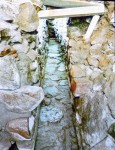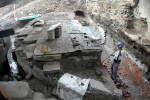 The search for the tombs of Aztec emperors inches closer to a possible conclusion with the discovery of two sealed chambers under the Templo Mayor of Tenochtitlan in downtown Mexico City. Archaeologists have discovered a narrow tunnel that leads into the center of a large circular ceremonial platform at the foot of the Great Temple. At the end of the tunnel are two doors sealed with masonry that archaeologists hope may hold the cremated remains of 15th century Aztec rulers.
The search for the tombs of Aztec emperors inches closer to a possible conclusion with the discovery of two sealed chambers under the Templo Mayor of Tenochtitlan in downtown Mexico City. Archaeologists have discovered a narrow tunnel that leads into the center of a large circular ceremonial platform at the foot of the Great Temple. At the end of the tunnel are two doors sealed with masonry that archaeologists hope may hold the cremated remains of 15th century Aztec rulers.
Elaborate Maya royal burials have been discovered in Mexico, for instance Pakal II’s massive sarcophagus in Palenque, but archaeologists have yet to find any tombs of Aztec rulers. The only historical sources to mention royal Aztec burials extant are accounts written by Spanish chroniclers like Bernardino de Sahagún and Diego Durán after the conquest that record that the remains of Aztec emperor Axayacatl (grandson of Moctezuma I), and his brothers and successors to the throne Tizoc and Ahuitzotl were each cremated on a great circular platform in the Templo Mayor complex called the Cuauhxicalco.
 The Cuauhxicalco in question was unearthed in 2011. While at least five are recorded as having existed in the temple complex, this was the only one discovered in the ritually significant area at the foot of the temple. The platform is studded with 14 carved snake heads and is more than 50 feet in diameter. It was built in the 15th century on the south side of the temple which was dedicated to Huitzilopochtli, the god of war and patron god of Tenochtitlan.
The Cuauhxicalco in question was unearthed in 2011. While at least five are recorded as having existed in the temple complex, this was the only one discovered in the ritually significant area at the foot of the temple. The platform is studded with 14 carved snake heads and is more than 50 feet in diameter. It was built in the 15th century on the south side of the temple which was dedicated to Huitzilopochtli, the god of war and patron god of Tenochtitlan.
In 2013, archaeologists excavating the north side of the Cuauhxicalco found a large slab of volcanic andesite embedded in the floor. After lifting the 3-ton slab, they found a hollow space underneath it filled with offerings. Inside an offering box were the stones of a dismantled wall. At the bottom of the offering box were a pair of skulls of young children between five and seven years old at time of death, the first three cervical vertebrae and the skeletal remains of one hand and two feet. This is the first find of child sacrifices with complete skulls including the mandibles and the bones of the neck included. Lead archaeologist Leonardo Lopez Lujan believes the remains of the children were interred right after death, which is why the vertebrae were there and why the feet and hand bones were articulated. The offering box also held gold objects, stone knives used in human sacrifices, the bones of eagles and one spectacular as yet unidentified artifact made of gilded obsidian. Underneath the box was another offering box containing the skull of an adult woman.
 The team was just about the rebury the offering boxes when one of the researchers, archaeologist Tomas Cruz, realized the south wall of the hollow space was hiding a narrow corridor just 18 inches wide and five feet high. They dug out the debris filling the hallway and found it led 27 feet to the center of the Cuauhxicalco, culminating in the two entrances, one facing east, one west, that had been walled off by the Aztecs.
The team was just about the rebury the offering boxes when one of the researchers, archaeologist Tomas Cruz, realized the south wall of the hollow space was hiding a narrow corridor just 18 inches wide and five feet high. They dug out the debris filling the hallway and found it led 27 feet to the center of the Cuauhxicalco, culminating in the two entrances, one facing east, one west, that had been walled off by the Aztecs.
But Lopez Lujan is being cautious, saying the presence of graves at the end of the newly found passageway is simply a theory that could be wrong. The blocked-up entrances will be excavated starting in 2016.
“What we are speculating is that behind these sealed-up entrances there could be two small chambers with the incinerated remains of some rulers of Tenochtitlan, like Moctezuma I and his successors, Axayacatl and Tízoc, given the relative dating of the surrounding constructions,” Lopez Lujan said. […]
Dr. Michael E. Smith, a professor of anthropology at Arizona State University who was not involved in the dig, said “Leonardo knows the archaeology and ethno-history better than anybody, and he is not one to grandstand or make fantastic claims to garner publicity. Thus I would think his prediction is reasonable.”
 They weren’t able to excavate of the chambers right away because construction of a new entrance hall to the Templo Mayor made the space inaccessible for two years. That’s almost complete now, so archaeologists will be able to pick up where they left off in January or February of next year. They expect to find two small rooms, no grand vaulted spaces like those created by the Maya.
They weren’t able to excavate of the chambers right away because construction of a new entrance hall to the Templo Mayor made the space inaccessible for two years. That’s almost complete now, so archaeologists will be able to pick up where they left off in January or February of next year. They expect to find two small rooms, no grand vaulted spaces like those created by the Maya.
In seven years of excavation, Lopez Lujan’s team has found 39 offerings containing more than 50,000 objects. Nine offerings were found before this excavation project began in 2007, for a total of 48. It’s the largest concentration of sacrificial deposits found in the temple complex, and they were found at the foot of the double staircase on the south side, not inside the pyramid, nor on any of the other sides. The concentration suggests this spot has greater ritual significance than the rest of the site, which, combined with the massive Cuauhxicalco, gives archaeologists reason to believe that any royal remains that may have been entombed in the temple were entombed in that location.